Law 11: Detailed Report on Negligence and Misrepresentation Torts
VerifiedAdded on 2020/02/24
|11
|2456
|34
Report
AI Summary
This report delves into the Australian tort law, specifically focusing on the torts of negligence and misrepresentation. It defines these torts, outlining their legal components, such as duty of care, breach of duty, and damages in negligence, and the requirements for establishing misrepresentation. The report explores the applicability of these torts in business contexts through case studies like Donoghue v Stevenson and Derry v Peek. It discusses the care required when giving advice to customers, potential consequences of negligence and misrepresentation, and available defenses. Real-life instances, like Jackson v McDonald's, are used to illustrate these concepts. The role of statutory and public authorities, particularly the Australian Competition and Consumer Commission (ACCC), and consumer authorities are examined, along with legal proceedings. The report also touches upon other types of torts, such as deceit, and concludes with recommendations for businesses and a summary of the key takeaways. This analysis provides students with a comprehensive understanding of tort law principles and their practical implications.
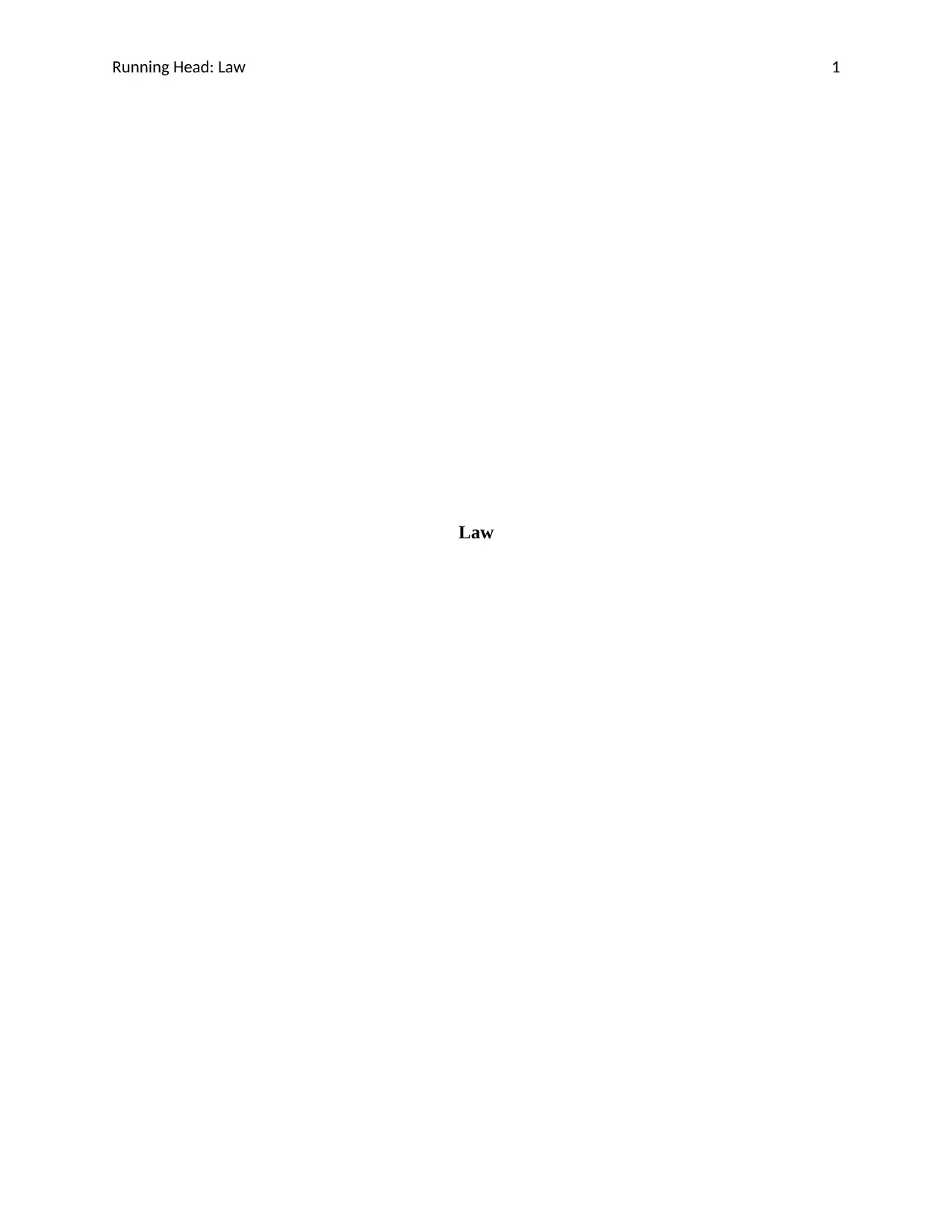
Running Head: Law 1
Law
Law
Paraphrase This Document
Need a fresh take? Get an instant paraphrase of this document with our AI Paraphraser
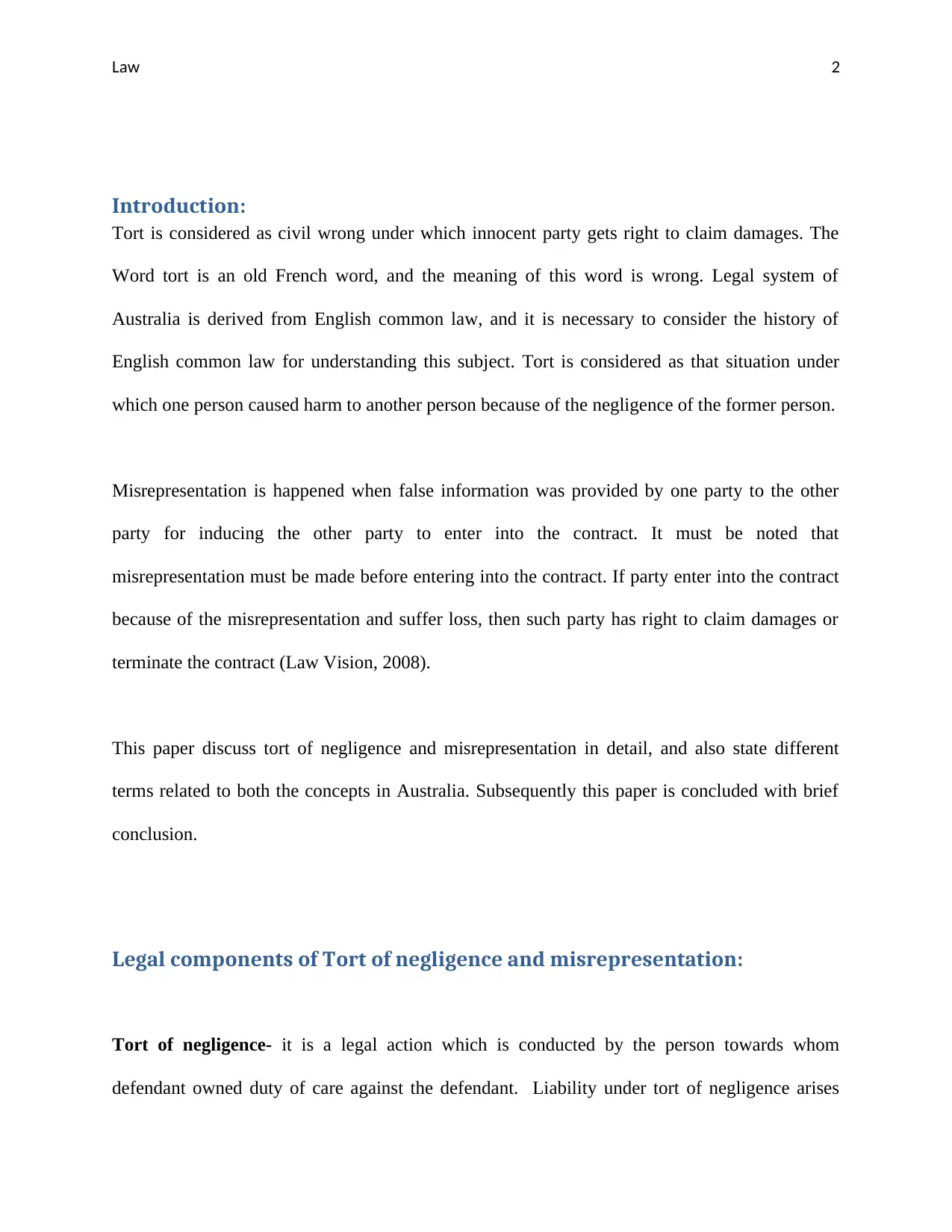
Law 2
Introduction:
Tort is considered as civil wrong under which innocent party gets right to claim damages. The
Word tort is an old French word, and the meaning of this word is wrong. Legal system of
Australia is derived from English common law, and it is necessary to consider the history of
English common law for understanding this subject. Tort is considered as that situation under
which one person caused harm to another person because of the negligence of the former person.
Misrepresentation is happened when false information was provided by one party to the other
party for inducing the other party to enter into the contract. It must be noted that
misrepresentation must be made before entering into the contract. If party enter into the contract
because of the misrepresentation and suffer loss, then such party has right to claim damages or
terminate the contract (Law Vision, 2008).
This paper discuss tort of negligence and misrepresentation in detail, and also state different
terms related to both the concepts in Australia. Subsequently this paper is concluded with brief
conclusion.
Legal components of Tort of negligence and misrepresentation:
Tort of negligence- it is a legal action which is conducted by the person towards whom
defendant owned duty of care against the defendant. Liability under tort of negligence arises
Introduction:
Tort is considered as civil wrong under which innocent party gets right to claim damages. The
Word tort is an old French word, and the meaning of this word is wrong. Legal system of
Australia is derived from English common law, and it is necessary to consider the history of
English common law for understanding this subject. Tort is considered as that situation under
which one person caused harm to another person because of the negligence of the former person.
Misrepresentation is happened when false information was provided by one party to the other
party for inducing the other party to enter into the contract. It must be noted that
misrepresentation must be made before entering into the contract. If party enter into the contract
because of the misrepresentation and suffer loss, then such party has right to claim damages or
terminate the contract (Law Vision, 2008).
This paper discuss tort of negligence and misrepresentation in detail, and also state different
terms related to both the concepts in Australia. Subsequently this paper is concluded with brief
conclusion.
Legal components of Tort of negligence and misrepresentation:
Tort of negligence- it is a legal action which is conducted by the person towards whom
defendant owned duty of care against the defendant. Liability under tort of negligence arises
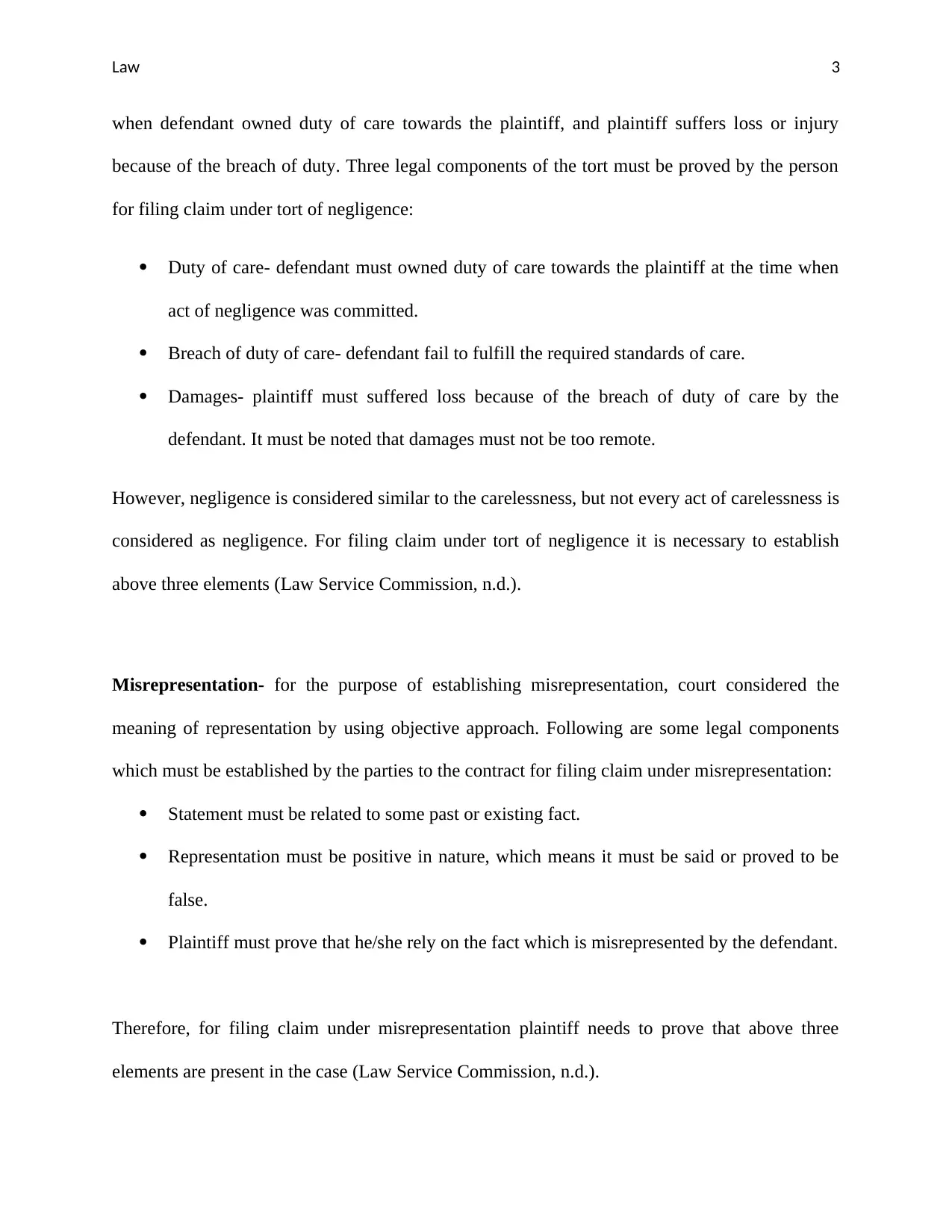
Law 3
when defendant owned duty of care towards the plaintiff, and plaintiff suffers loss or injury
because of the breach of duty. Three legal components of the tort must be proved by the person
for filing claim under tort of negligence:
Duty of care- defendant must owned duty of care towards the plaintiff at the time when
act of negligence was committed.
Breach of duty of care- defendant fail to fulfill the required standards of care.
Damages- plaintiff must suffered loss because of the breach of duty of care by the
defendant. It must be noted that damages must not be too remote.
However, negligence is considered similar to the carelessness, but not every act of carelessness is
considered as negligence. For filing claim under tort of negligence it is necessary to establish
above three elements (Law Service Commission, n.d.).
Misrepresentation- for the purpose of establishing misrepresentation, court considered the
meaning of representation by using objective approach. Following are some legal components
which must be established by the parties to the contract for filing claim under misrepresentation:
Statement must be related to some past or existing fact.
Representation must be positive in nature, which means it must be said or proved to be
false.
Plaintiff must prove that he/she rely on the fact which is misrepresented by the defendant.
Therefore, for filing claim under misrepresentation plaintiff needs to prove that above three
elements are present in the case (Law Service Commission, n.d.).
when defendant owned duty of care towards the plaintiff, and plaintiff suffers loss or injury
because of the breach of duty. Three legal components of the tort must be proved by the person
for filing claim under tort of negligence:
Duty of care- defendant must owned duty of care towards the plaintiff at the time when
act of negligence was committed.
Breach of duty of care- defendant fail to fulfill the required standards of care.
Damages- plaintiff must suffered loss because of the breach of duty of care by the
defendant. It must be noted that damages must not be too remote.
However, negligence is considered similar to the carelessness, but not every act of carelessness is
considered as negligence. For filing claim under tort of negligence it is necessary to establish
above three elements (Law Service Commission, n.d.).
Misrepresentation- for the purpose of establishing misrepresentation, court considered the
meaning of representation by using objective approach. Following are some legal components
which must be established by the parties to the contract for filing claim under misrepresentation:
Statement must be related to some past or existing fact.
Representation must be positive in nature, which means it must be said or proved to be
false.
Plaintiff must prove that he/she rely on the fact which is misrepresented by the defendant.
Therefore, for filing claim under misrepresentation plaintiff needs to prove that above three
elements are present in the case (Law Service Commission, n.d.).
⊘ This is a preview!⊘
Do you want full access?
Subscribe today to unlock all pages.

Trusted by 1+ million students worldwide
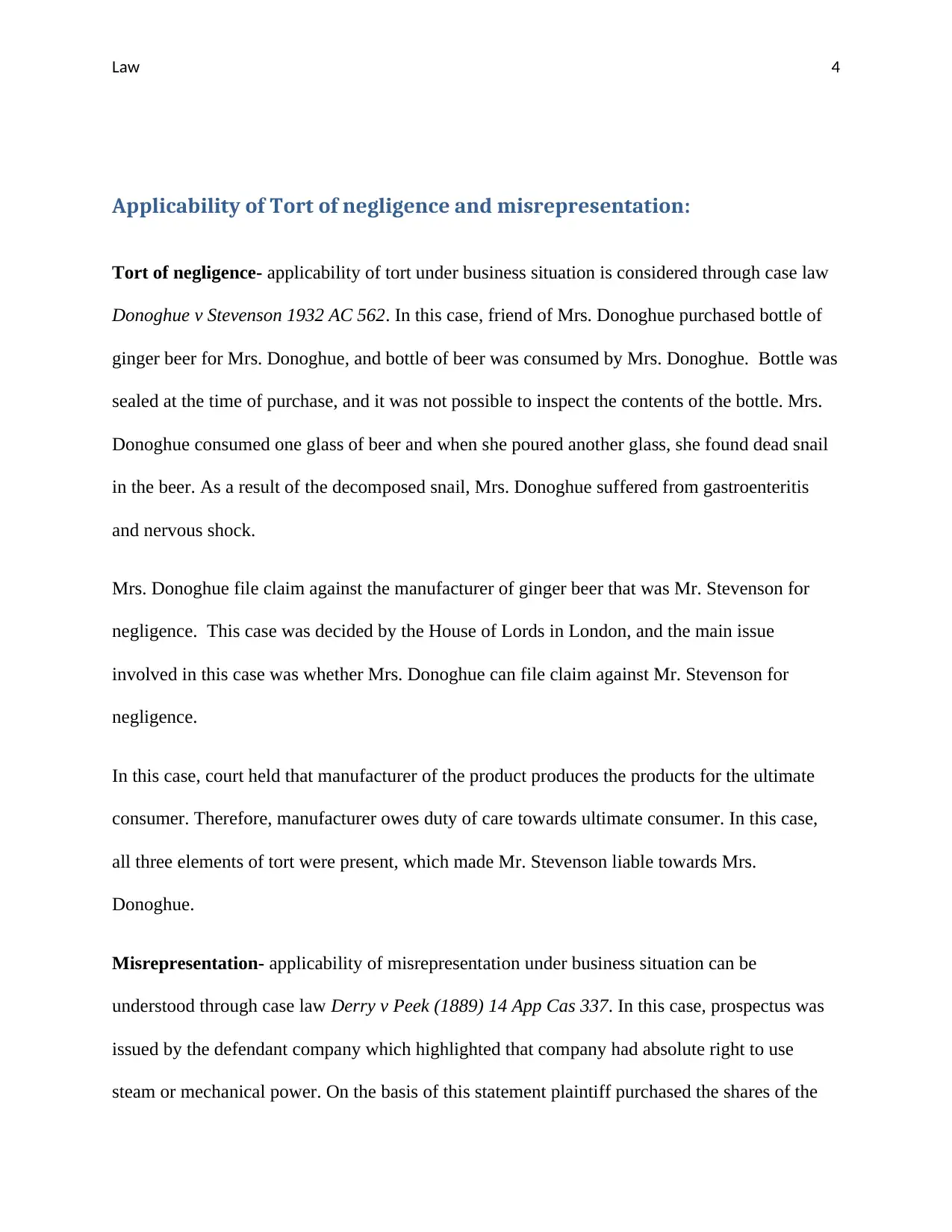
Law 4
Applicability of Tort of negligence and misrepresentation:
Tort of negligence- applicability of tort under business situation is considered through case law
Donoghue v Stevenson 1932 AC 562. In this case, friend of Mrs. Donoghue purchased bottle of
ginger beer for Mrs. Donoghue, and bottle of beer was consumed by Mrs. Donoghue. Bottle was
sealed at the time of purchase, and it was not possible to inspect the contents of the bottle. Mrs.
Donoghue consumed one glass of beer and when she poured another glass, she found dead snail
in the beer. As a result of the decomposed snail, Mrs. Donoghue suffered from gastroenteritis
and nervous shock.
Mrs. Donoghue file claim against the manufacturer of ginger beer that was Mr. Stevenson for
negligence. This case was decided by the House of Lords in London, and the main issue
involved in this case was whether Mrs. Donoghue can file claim against Mr. Stevenson for
negligence.
In this case, court held that manufacturer of the product produces the products for the ultimate
consumer. Therefore, manufacturer owes duty of care towards ultimate consumer. In this case,
all three elements of tort were present, which made Mr. Stevenson liable towards Mrs.
Donoghue.
Misrepresentation- applicability of misrepresentation under business situation can be
understood through case law Derry v Peek (1889) 14 App Cas 337. In this case, prospectus was
issued by the defendant company which highlighted that company had absolute right to use
steam or mechanical power. On the basis of this statement plaintiff purchased the shares of the
Applicability of Tort of negligence and misrepresentation:
Tort of negligence- applicability of tort under business situation is considered through case law
Donoghue v Stevenson 1932 AC 562. In this case, friend of Mrs. Donoghue purchased bottle of
ginger beer for Mrs. Donoghue, and bottle of beer was consumed by Mrs. Donoghue. Bottle was
sealed at the time of purchase, and it was not possible to inspect the contents of the bottle. Mrs.
Donoghue consumed one glass of beer and when she poured another glass, she found dead snail
in the beer. As a result of the decomposed snail, Mrs. Donoghue suffered from gastroenteritis
and nervous shock.
Mrs. Donoghue file claim against the manufacturer of ginger beer that was Mr. Stevenson for
negligence. This case was decided by the House of Lords in London, and the main issue
involved in this case was whether Mrs. Donoghue can file claim against Mr. Stevenson for
negligence.
In this case, court held that manufacturer of the product produces the products for the ultimate
consumer. Therefore, manufacturer owes duty of care towards ultimate consumer. In this case,
all three elements of tort were present, which made Mr. Stevenson liable towards Mrs.
Donoghue.
Misrepresentation- applicability of misrepresentation under business situation can be
understood through case law Derry v Peek (1889) 14 App Cas 337. In this case, prospectus was
issued by the defendant company which highlighted that company had absolute right to use
steam or mechanical power. On the basis of this statement plaintiff purchased the shares of the
Paraphrase This Document
Need a fresh take? Get an instant paraphrase of this document with our AI Paraphraser
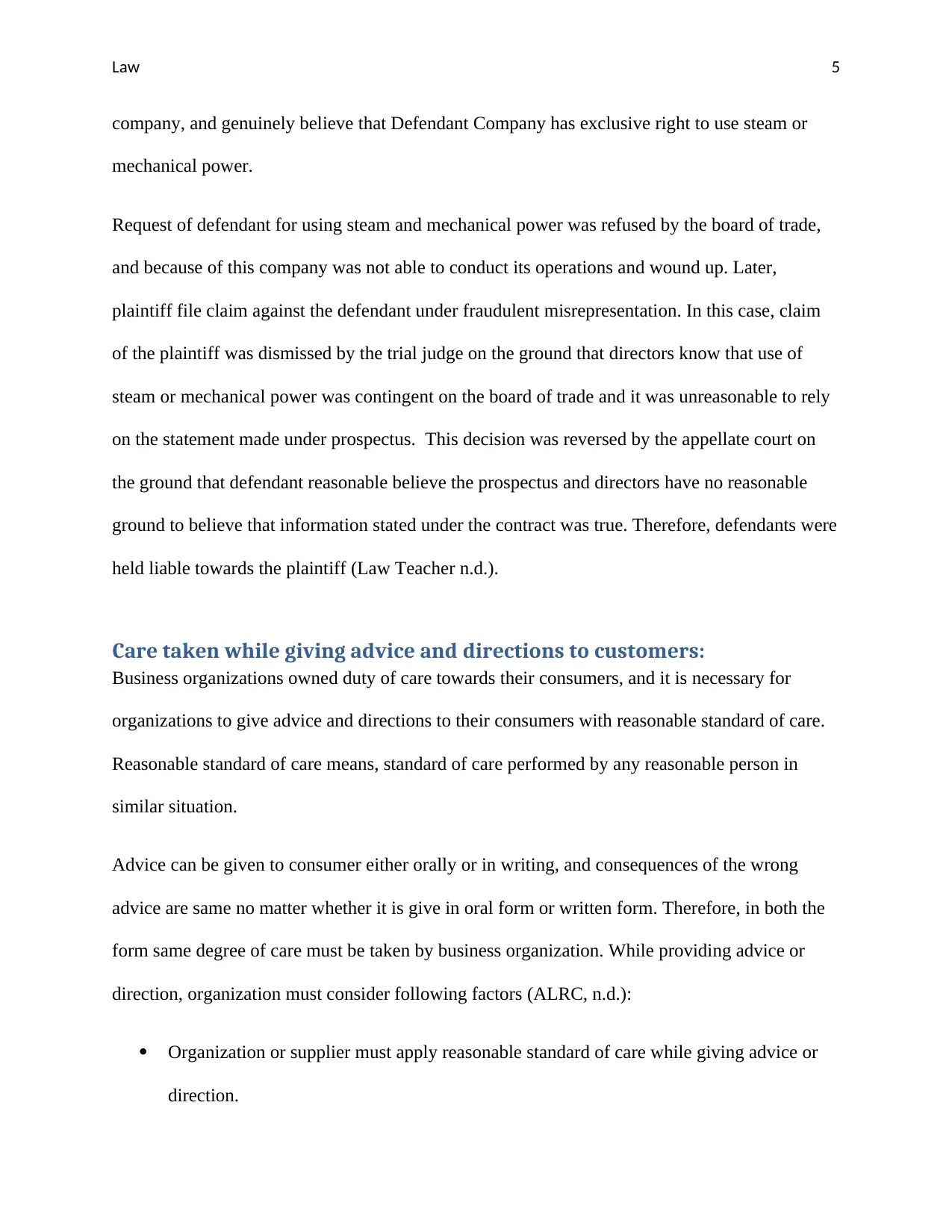
Law 5
company, and genuinely believe that Defendant Company has exclusive right to use steam or
mechanical power.
Request of defendant for using steam and mechanical power was refused by the board of trade,
and because of this company was not able to conduct its operations and wound up. Later,
plaintiff file claim against the defendant under fraudulent misrepresentation. In this case, claim
of the plaintiff was dismissed by the trial judge on the ground that directors know that use of
steam or mechanical power was contingent on the board of trade and it was unreasonable to rely
on the statement made under prospectus. This decision was reversed by the appellate court on
the ground that defendant reasonable believe the prospectus and directors have no reasonable
ground to believe that information stated under the contract was true. Therefore, defendants were
held liable towards the plaintiff (Law Teacher n.d.).
Care taken while giving advice and directions to customers:
Business organizations owned duty of care towards their consumers, and it is necessary for
organizations to give advice and directions to their consumers with reasonable standard of care.
Reasonable standard of care means, standard of care performed by any reasonable person in
similar situation.
Advice can be given to consumer either orally or in writing, and consequences of the wrong
advice are same no matter whether it is give in oral form or written form. Therefore, in both the
form same degree of care must be taken by business organization. While providing advice or
direction, organization must consider following factors (ALRC, n.d.):
Organization or supplier must apply reasonable standard of care while giving advice or
direction.
company, and genuinely believe that Defendant Company has exclusive right to use steam or
mechanical power.
Request of defendant for using steam and mechanical power was refused by the board of trade,
and because of this company was not able to conduct its operations and wound up. Later,
plaintiff file claim against the defendant under fraudulent misrepresentation. In this case, claim
of the plaintiff was dismissed by the trial judge on the ground that directors know that use of
steam or mechanical power was contingent on the board of trade and it was unreasonable to rely
on the statement made under prospectus. This decision was reversed by the appellate court on
the ground that defendant reasonable believe the prospectus and directors have no reasonable
ground to believe that information stated under the contract was true. Therefore, defendants were
held liable towards the plaintiff (Law Teacher n.d.).
Care taken while giving advice and directions to customers:
Business organizations owned duty of care towards their consumers, and it is necessary for
organizations to give advice and directions to their consumers with reasonable standard of care.
Reasonable standard of care means, standard of care performed by any reasonable person in
similar situation.
Advice can be given to consumer either orally or in writing, and consequences of the wrong
advice are same no matter whether it is give in oral form or written form. Therefore, in both the
form same degree of care must be taken by business organization. While providing advice or
direction, organization must consider following factors (ALRC, n.d.):
Organization or supplier must apply reasonable standard of care while giving advice or
direction.
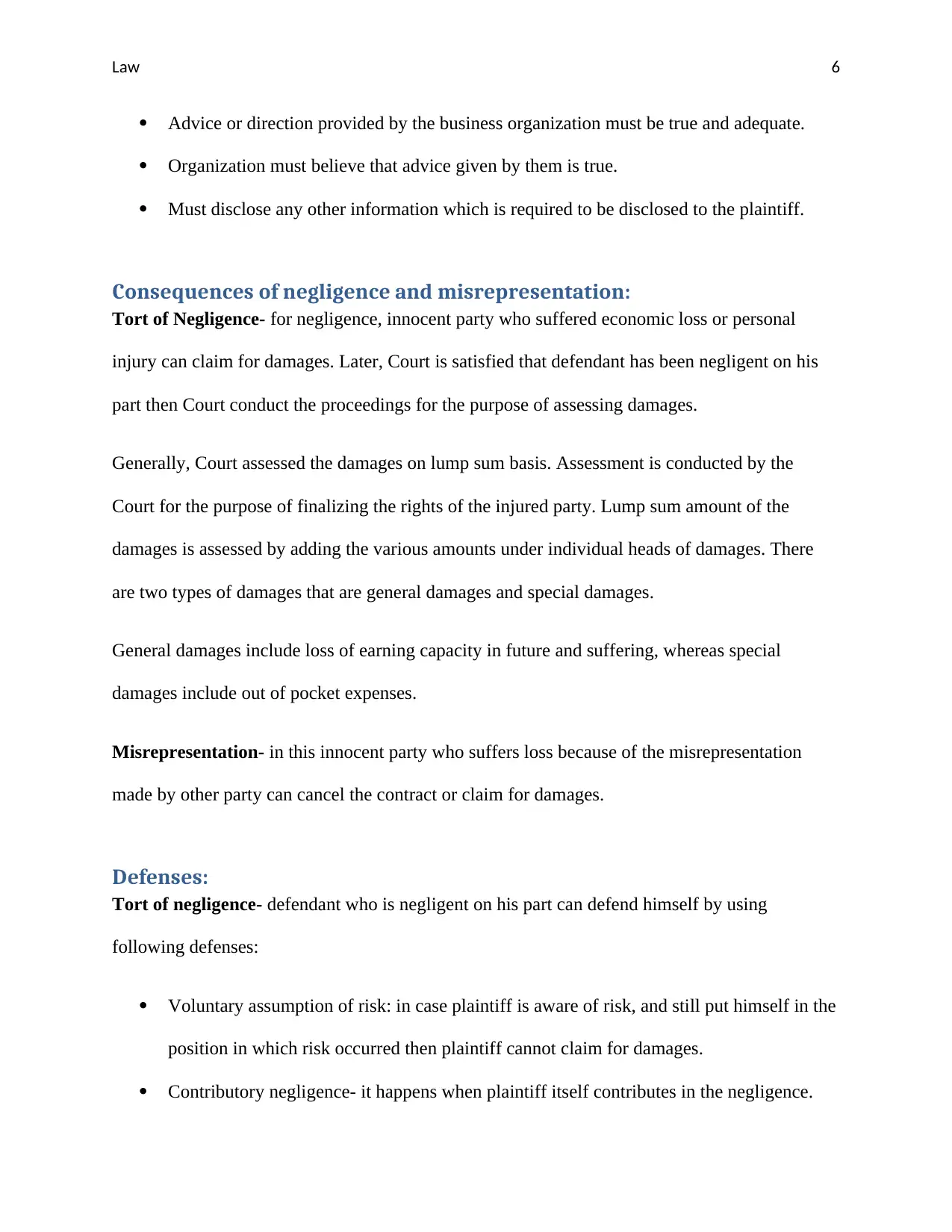
Law 6
Advice or direction provided by the business organization must be true and adequate.
Organization must believe that advice given by them is true.
Must disclose any other information which is required to be disclosed to the plaintiff.
Consequences of negligence and misrepresentation:
Tort of Negligence- for negligence, innocent party who suffered economic loss or personal
injury can claim for damages. Later, Court is satisfied that defendant has been negligent on his
part then Court conduct the proceedings for the purpose of assessing damages.
Generally, Court assessed the damages on lump sum basis. Assessment is conducted by the
Court for the purpose of finalizing the rights of the injured party. Lump sum amount of the
damages is assessed by adding the various amounts under individual heads of damages. There
are two types of damages that are general damages and special damages.
General damages include loss of earning capacity in future and suffering, whereas special
damages include out of pocket expenses.
Misrepresentation- in this innocent party who suffers loss because of the misrepresentation
made by other party can cancel the contract or claim for damages.
Defenses:
Tort of negligence- defendant who is negligent on his part can defend himself by using
following defenses:
Voluntary assumption of risk: in case plaintiff is aware of risk, and still put himself in the
position in which risk occurred then plaintiff cannot claim for damages.
Contributory negligence- it happens when plaintiff itself contributes in the negligence.
Advice or direction provided by the business organization must be true and adequate.
Organization must believe that advice given by them is true.
Must disclose any other information which is required to be disclosed to the plaintiff.
Consequences of negligence and misrepresentation:
Tort of Negligence- for negligence, innocent party who suffered economic loss or personal
injury can claim for damages. Later, Court is satisfied that defendant has been negligent on his
part then Court conduct the proceedings for the purpose of assessing damages.
Generally, Court assessed the damages on lump sum basis. Assessment is conducted by the
Court for the purpose of finalizing the rights of the injured party. Lump sum amount of the
damages is assessed by adding the various amounts under individual heads of damages. There
are two types of damages that are general damages and special damages.
General damages include loss of earning capacity in future and suffering, whereas special
damages include out of pocket expenses.
Misrepresentation- in this innocent party who suffers loss because of the misrepresentation
made by other party can cancel the contract or claim for damages.
Defenses:
Tort of negligence- defendant who is negligent on his part can defend himself by using
following defenses:
Voluntary assumption of risk: in case plaintiff is aware of risk, and still put himself in the
position in which risk occurred then plaintiff cannot claim for damages.
Contributory negligence- it happens when plaintiff itself contributes in the negligence.
⊘ This is a preview!⊘
Do you want full access?
Subscribe today to unlock all pages.

Trusted by 1+ million students worldwide
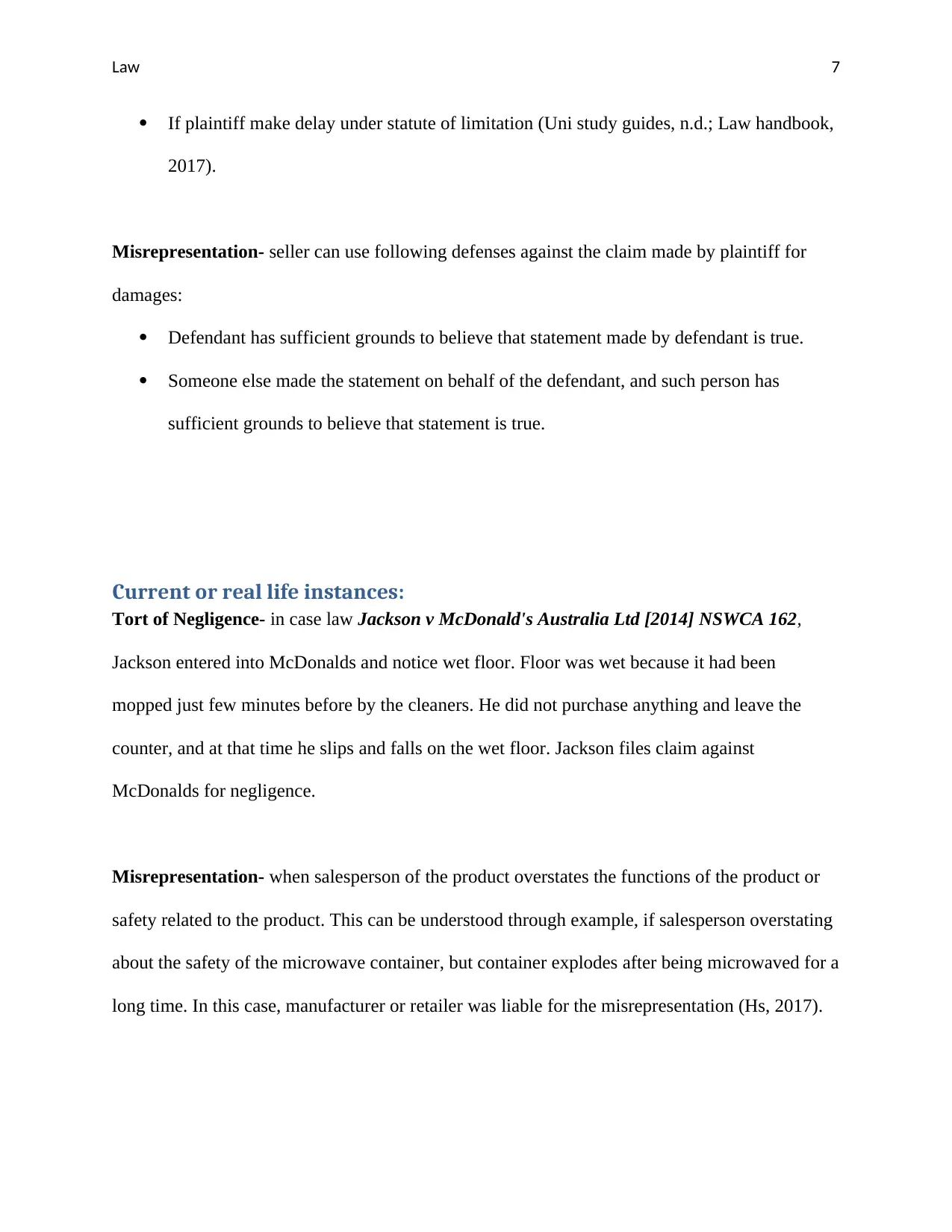
Law 7
If plaintiff make delay under statute of limitation (Uni study guides, n.d.; Law handbook,
2017).
Misrepresentation- seller can use following defenses against the claim made by plaintiff for
damages:
Defendant has sufficient grounds to believe that statement made by defendant is true.
Someone else made the statement on behalf of the defendant, and such person has
sufficient grounds to believe that statement is true.
Current or real life instances:
Tort of Negligence- in case law Jackson v McDonald's Australia Ltd [2014] NSWCA 162,
Jackson entered into McDonalds and notice wet floor. Floor was wet because it had been
mopped just few minutes before by the cleaners. He did not purchase anything and leave the
counter, and at that time he slips and falls on the wet floor. Jackson files claim against
McDonalds for negligence.
Misrepresentation- when salesperson of the product overstates the functions of the product or
safety related to the product. This can be understood through example, if salesperson overstating
about the safety of the microwave container, but container explodes after being microwaved for a
long time. In this case, manufacturer or retailer was liable for the misrepresentation (Hs, 2017).
If plaintiff make delay under statute of limitation (Uni study guides, n.d.; Law handbook,
2017).
Misrepresentation- seller can use following defenses against the claim made by plaintiff for
damages:
Defendant has sufficient grounds to believe that statement made by defendant is true.
Someone else made the statement on behalf of the defendant, and such person has
sufficient grounds to believe that statement is true.
Current or real life instances:
Tort of Negligence- in case law Jackson v McDonald's Australia Ltd [2014] NSWCA 162,
Jackson entered into McDonalds and notice wet floor. Floor was wet because it had been
mopped just few minutes before by the cleaners. He did not purchase anything and leave the
counter, and at that time he slips and falls on the wet floor. Jackson files claim against
McDonalds for negligence.
Misrepresentation- when salesperson of the product overstates the functions of the product or
safety related to the product. This can be understood through example, if salesperson overstating
about the safety of the microwave container, but container explodes after being microwaved for a
long time. In this case, manufacturer or retailer was liable for the misrepresentation (Hs, 2017).
Paraphrase This Document
Need a fresh take? Get an instant paraphrase of this document with our AI Paraphraser
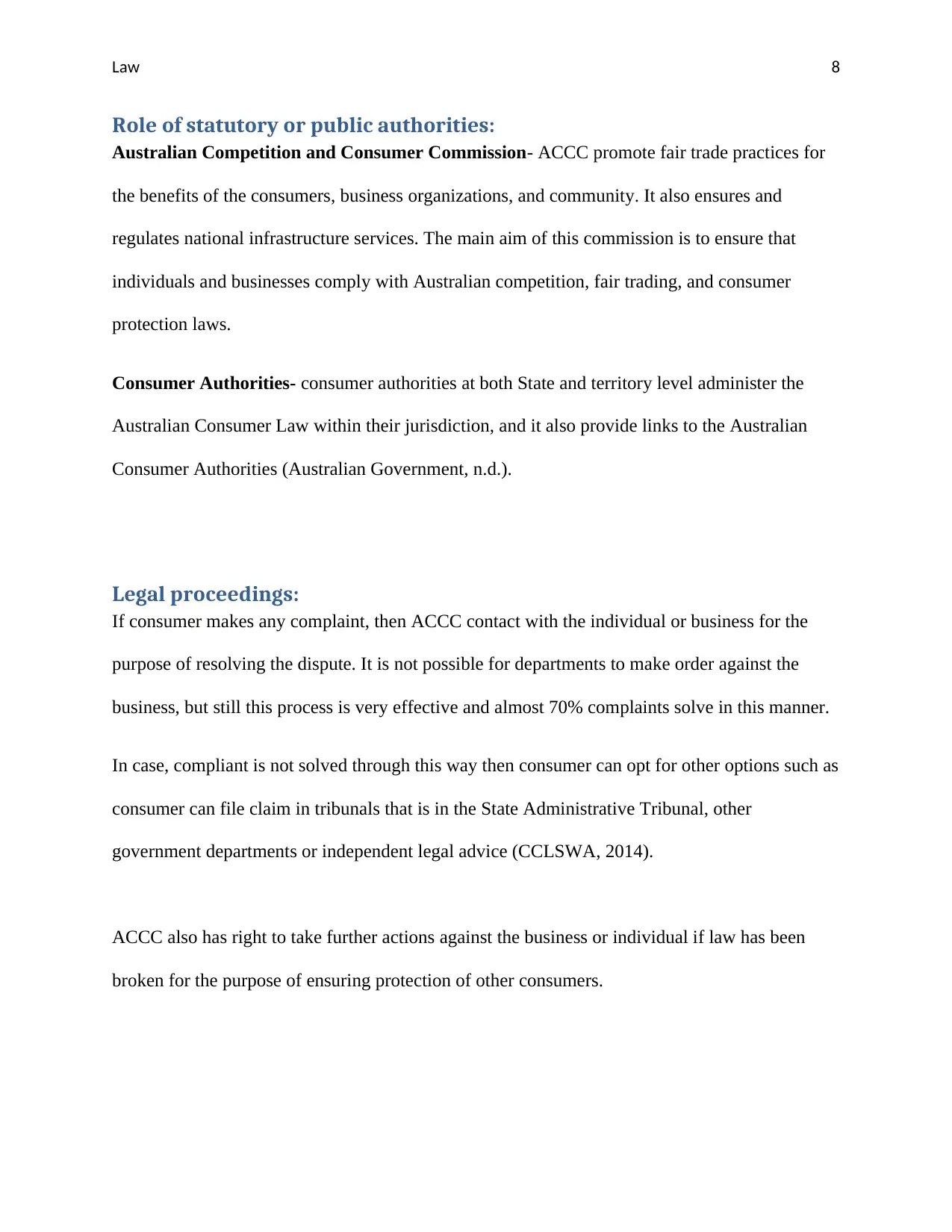
Law 8
Role of statutory or public authorities:
Australian Competition and Consumer Commission- ACCC promote fair trade practices for
the benefits of the consumers, business organizations, and community. It also ensures and
regulates national infrastructure services. The main aim of this commission is to ensure that
individuals and businesses comply with Australian competition, fair trading, and consumer
protection laws.
Consumer Authorities- consumer authorities at both State and territory level administer the
Australian Consumer Law within their jurisdiction, and it also provide links to the Australian
Consumer Authorities (Australian Government, n.d.).
Legal proceedings:
If consumer makes any complaint, then ACCC contact with the individual or business for the
purpose of resolving the dispute. It is not possible for departments to make order against the
business, but still this process is very effective and almost 70% complaints solve in this manner.
In case, compliant is not solved through this way then consumer can opt for other options such as
consumer can file claim in tribunals that is in the State Administrative Tribunal, other
government departments or independent legal advice (CCLSWA, 2014).
ACCC also has right to take further actions against the business or individual if law has been
broken for the purpose of ensuring protection of other consumers.
Role of statutory or public authorities:
Australian Competition and Consumer Commission- ACCC promote fair trade practices for
the benefits of the consumers, business organizations, and community. It also ensures and
regulates national infrastructure services. The main aim of this commission is to ensure that
individuals and businesses comply with Australian competition, fair trading, and consumer
protection laws.
Consumer Authorities- consumer authorities at both State and territory level administer the
Australian Consumer Law within their jurisdiction, and it also provide links to the Australian
Consumer Authorities (Australian Government, n.d.).
Legal proceedings:
If consumer makes any complaint, then ACCC contact with the individual or business for the
purpose of resolving the dispute. It is not possible for departments to make order against the
business, but still this process is very effective and almost 70% complaints solve in this manner.
In case, compliant is not solved through this way then consumer can opt for other options such as
consumer can file claim in tribunals that is in the State Administrative Tribunal, other
government departments or independent legal advice (CCLSWA, 2014).
ACCC also has right to take further actions against the business or individual if law has been
broken for the purpose of ensuring protection of other consumers.
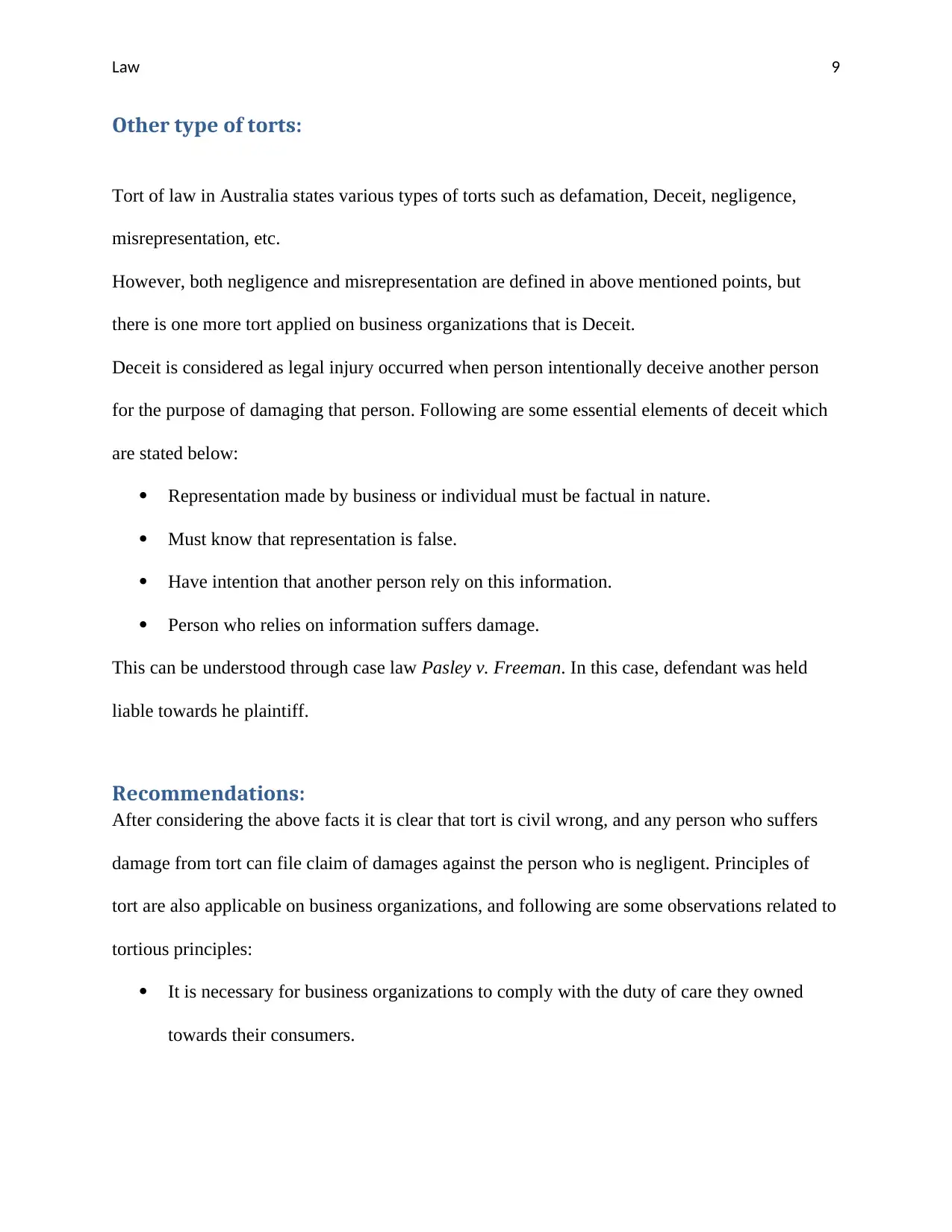
Law 9
Other type of torts:
Tort of law in Australia states various types of torts such as defamation, Deceit, negligence,
misrepresentation, etc.
However, both negligence and misrepresentation are defined in above mentioned points, but
there is one more tort applied on business organizations that is Deceit.
Deceit is considered as legal injury occurred when person intentionally deceive another person
for the purpose of damaging that person. Following are some essential elements of deceit which
are stated below:
Representation made by business or individual must be factual in nature.
Must know that representation is false.
Have intention that another person rely on this information.
Person who relies on information suffers damage.
This can be understood through case law Pasley v. Freeman. In this case, defendant was held
liable towards he plaintiff.
Recommendations:
After considering the above facts it is clear that tort is civil wrong, and any person who suffers
damage from tort can file claim of damages against the person who is negligent. Principles of
tort are also applicable on business organizations, and following are some observations related to
tortious principles:
It is necessary for business organizations to comply with the duty of care they owned
towards their consumers.
Other type of torts:
Tort of law in Australia states various types of torts such as defamation, Deceit, negligence,
misrepresentation, etc.
However, both negligence and misrepresentation are defined in above mentioned points, but
there is one more tort applied on business organizations that is Deceit.
Deceit is considered as legal injury occurred when person intentionally deceive another person
for the purpose of damaging that person. Following are some essential elements of deceit which
are stated below:
Representation made by business or individual must be factual in nature.
Must know that representation is false.
Have intention that another person rely on this information.
Person who relies on information suffers damage.
This can be understood through case law Pasley v. Freeman. In this case, defendant was held
liable towards he plaintiff.
Recommendations:
After considering the above facts it is clear that tort is civil wrong, and any person who suffers
damage from tort can file claim of damages against the person who is negligent. Principles of
tort are also applicable on business organizations, and following are some observations related to
tortious principles:
It is necessary for business organizations to comply with the duty of care they owned
towards their consumers.
⊘ This is a preview!⊘
Do you want full access?
Subscribe today to unlock all pages.

Trusted by 1+ million students worldwide
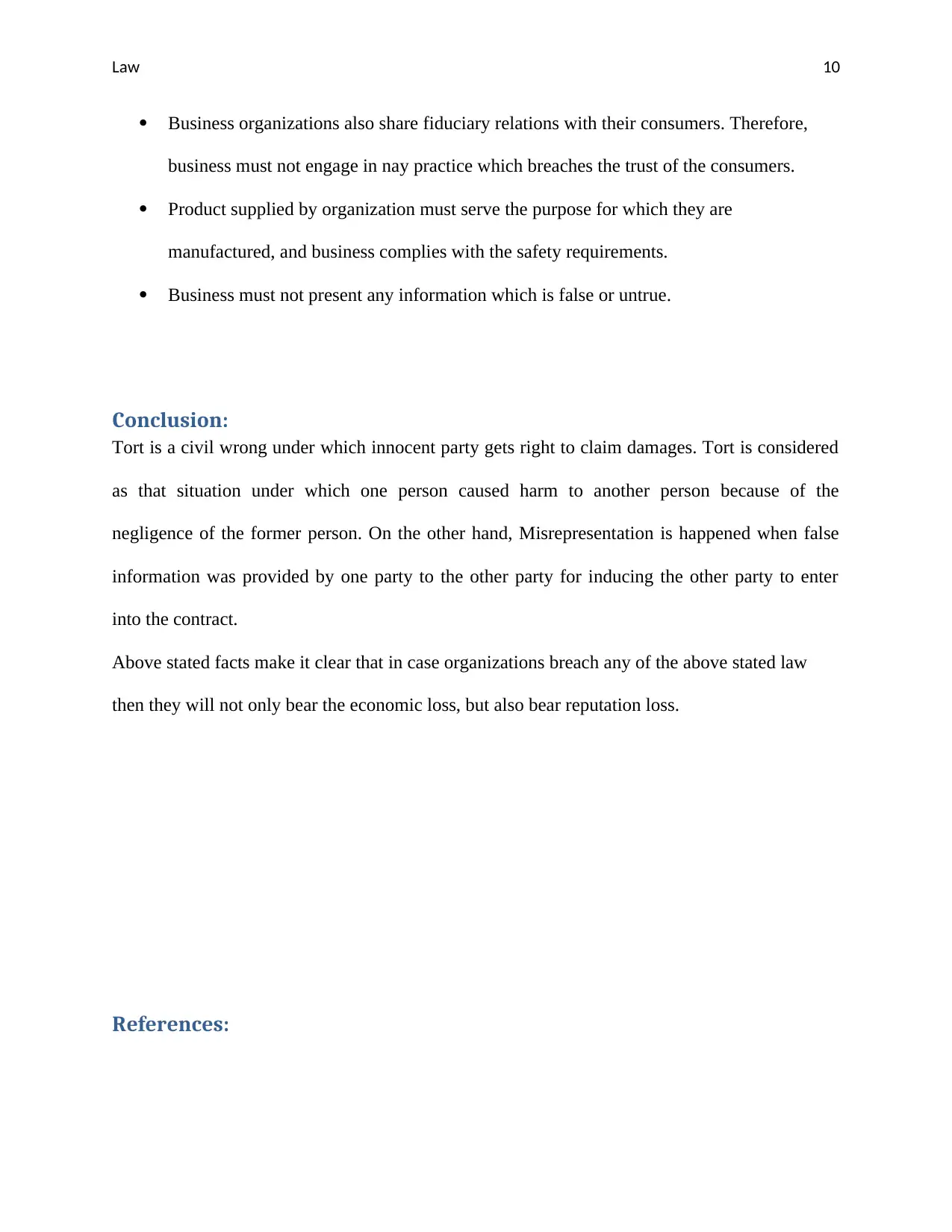
Law 10
Business organizations also share fiduciary relations with their consumers. Therefore,
business must not engage in nay practice which breaches the trust of the consumers.
Product supplied by organization must serve the purpose for which they are
manufactured, and business complies with the safety requirements.
Business must not present any information which is false or untrue.
Conclusion:
Tort is a civil wrong under which innocent party gets right to claim damages. Tort is considered
as that situation under which one person caused harm to another person because of the
negligence of the former person. On the other hand, Misrepresentation is happened when false
information was provided by one party to the other party for inducing the other party to enter
into the contract.
Above stated facts make it clear that in case organizations breach any of the above stated law
then they will not only bear the economic loss, but also bear reputation loss.
References:
Business organizations also share fiduciary relations with their consumers. Therefore,
business must not engage in nay practice which breaches the trust of the consumers.
Product supplied by organization must serve the purpose for which they are
manufactured, and business complies with the safety requirements.
Business must not present any information which is false or untrue.
Conclusion:
Tort is a civil wrong under which innocent party gets right to claim damages. Tort is considered
as that situation under which one person caused harm to another person because of the
negligence of the former person. On the other hand, Misrepresentation is happened when false
information was provided by one party to the other party for inducing the other party to enter
into the contract.
Above stated facts make it clear that in case organizations breach any of the above stated law
then they will not only bear the economic loss, but also bear reputation loss.
References:
Paraphrase This Document
Need a fresh take? Get an instant paraphrase of this document with our AI Paraphraser
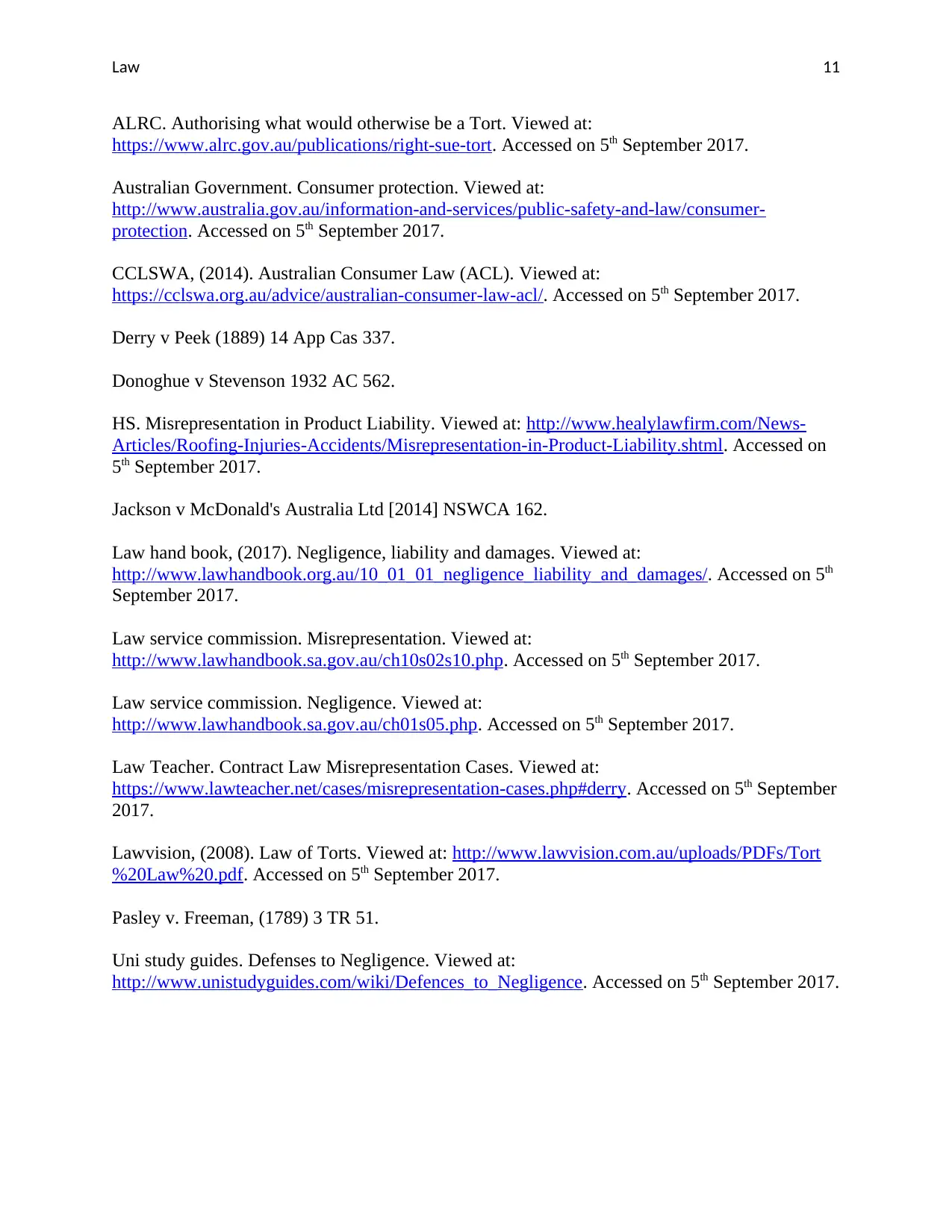
Law 11
ALRC. Authorising what would otherwise be a Tort. Viewed at:
https://www.alrc.gov.au/publications/right-sue-tort. Accessed on 5th September 2017.
Australian Government. Consumer protection. Viewed at:
http://www.australia.gov.au/information-and-services/public-safety-and-law/consumer-
protection. Accessed on 5th September 2017.
CCLSWA, (2014). Australian Consumer Law (ACL). Viewed at:
https://cclswa.org.au/advice/australian-consumer-law-acl/. Accessed on 5th September 2017.
Derry v Peek (1889) 14 App Cas 337.
Donoghue v Stevenson 1932 AC 562.
HS. Misrepresentation in Product Liability. Viewed at: http://www.healylawfirm.com/News-
Articles/Roofing-Injuries-Accidents/Misrepresentation-in-Product-Liability.shtml. Accessed on
5th September 2017.
Jackson v McDonald's Australia Ltd [2014] NSWCA 162.
Law hand book, (2017). Negligence, liability and damages. Viewed at:
http://www.lawhandbook.org.au/10_01_01_negligence_liability_and_damages/. Accessed on 5th
September 2017.
Law service commission. Misrepresentation. Viewed at:
http://www.lawhandbook.sa.gov.au/ch10s02s10.php. Accessed on 5th September 2017.
Law service commission. Negligence. Viewed at:
http://www.lawhandbook.sa.gov.au/ch01s05.php. Accessed on 5th September 2017.
Law Teacher. Contract Law Misrepresentation Cases. Viewed at:
https://www.lawteacher.net/cases/misrepresentation-cases.php#derry. Accessed on 5th September
2017.
Lawvision, (2008). Law of Torts. Viewed at: http://www.lawvision.com.au/uploads/PDFs/Tort
%20Law%20.pdf. Accessed on 5th September 2017.
Pasley v. Freeman, (1789) 3 TR 51.
Uni study guides. Defenses to Negligence. Viewed at:
http://www.unistudyguides.com/wiki/Defences_to_Negligence. Accessed on 5th September 2017.
ALRC. Authorising what would otherwise be a Tort. Viewed at:
https://www.alrc.gov.au/publications/right-sue-tort. Accessed on 5th September 2017.
Australian Government. Consumer protection. Viewed at:
http://www.australia.gov.au/information-and-services/public-safety-and-law/consumer-
protection. Accessed on 5th September 2017.
CCLSWA, (2014). Australian Consumer Law (ACL). Viewed at:
https://cclswa.org.au/advice/australian-consumer-law-acl/. Accessed on 5th September 2017.
Derry v Peek (1889) 14 App Cas 337.
Donoghue v Stevenson 1932 AC 562.
HS. Misrepresentation in Product Liability. Viewed at: http://www.healylawfirm.com/News-
Articles/Roofing-Injuries-Accidents/Misrepresentation-in-Product-Liability.shtml. Accessed on
5th September 2017.
Jackson v McDonald's Australia Ltd [2014] NSWCA 162.
Law hand book, (2017). Negligence, liability and damages. Viewed at:
http://www.lawhandbook.org.au/10_01_01_negligence_liability_and_damages/. Accessed on 5th
September 2017.
Law service commission. Misrepresentation. Viewed at:
http://www.lawhandbook.sa.gov.au/ch10s02s10.php. Accessed on 5th September 2017.
Law service commission. Negligence. Viewed at:
http://www.lawhandbook.sa.gov.au/ch01s05.php. Accessed on 5th September 2017.
Law Teacher. Contract Law Misrepresentation Cases. Viewed at:
https://www.lawteacher.net/cases/misrepresentation-cases.php#derry. Accessed on 5th September
2017.
Lawvision, (2008). Law of Torts. Viewed at: http://www.lawvision.com.au/uploads/PDFs/Tort
%20Law%20.pdf. Accessed on 5th September 2017.
Pasley v. Freeman, (1789) 3 TR 51.
Uni study guides. Defenses to Negligence. Viewed at:
http://www.unistudyguides.com/wiki/Defences_to_Negligence. Accessed on 5th September 2017.
1 out of 11
Related Documents
Your All-in-One AI-Powered Toolkit for Academic Success.
+13062052269
info@desklib.com
Available 24*7 on WhatsApp / Email
![[object Object]](/_next/static/media/star-bottom.7253800d.svg)
Unlock your academic potential
Copyright © 2020–2025 A2Z Services. All Rights Reserved. Developed and managed by ZUCOL.




